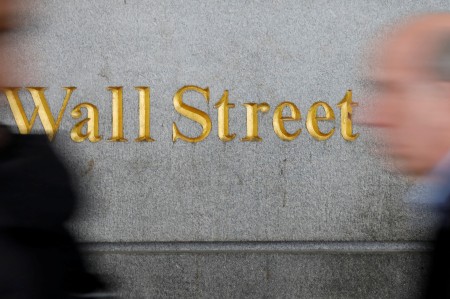(Reuters) -The S&P 500 fell more than 2% and the Nasdaq more than 3% at one point late on Thursday, reversing early gains after data spurred concerns the economy may be slowing to fast the Federal Reserve maintains a restrictive monetary policy.
Equities were initially buoyed by gains in Meta Platforms META.O after its quarterly results topped expectations and the Facebook parent issued an upbeat outlook for the third quarter. Its shares were last up 4.37% and $495.55. But concerns over AI-related earnings and the outlook for megacap stocks has hit the market during several recent sessions.
Stocks turned lower after data showed a measure of manufacturing activity from the Institute for Supply Management (ISM) dropped to an eight-month low in July at 46.8, signifying contraction.
The S&P 500 was down 1.36% in late trade, at 5,446.90 and the Nasdaq Composite lost 2.24%, to 17,204.798. The Dow Jones Industrial Average was 1.32% lower at 40,305.14.
COMMENTS:
STEVE SOSNICK, MARKET STRATEGIST, INTERACTIVE BROKERS, GREENWICH, CT
“I didn’t get a lot of calls yesterday when stocks were up by the same amount, because the general perception is that stocks go up. When they go up, you don’t need much of a reason. You need a reason when they go down. Yesterday was socially acceptable volatility. The magnitude of both days’ moves, one after the other, is what is alarming people. I was stunned at the ferocity of the move yesterday. For better worse, that’s just the unwinding of the move.”
“Even though the jobless claims and ISM data weren’t atrociously terrible, they remind people that if you’ve already priced in three rate cuts and the economy is cracking, how much more runway do you have to cut? That’s why you’re seeing bonds rip higher.”
“Without a good economy, these economically sensitive small stocks just won’t do anything, even with rate cuts. For them, it’s not just the Fed funds rate that is important; it’s more about whether or not they can access the high-yield debt market. And if the economy struggles, that won’t happen.”
LOU BASENESE, PRESIDENT AND CHIEF MARKET STRATEGIST, MDB CAPITAL, NEW YORK (via text)
“Markets turned almost immediately on the second weak ISM manufacturing reading in a row. Why? Because it raises a genuine fear that the Fed is behind on cutting rates. Few investors have confidence in the Fed sticking the proverbial soft landing and now the data is starting to support those concerns. Jobs report tomorrow will be key to stopping the bleeding or making it worse. A weaker than expected jobs report would be another data point in a growing set the economy is rolling over faster than the Fed can combat it with a rate cut.”
CAROL SCHLEIF, CHIEF INVESTMENT OFFICER, BMO FAMILY OFFICE IN MINNEAPOLIS, MINNESOTA
“You’ve two big tech companies reporting today. We’ve the Fed out of the way yesterday so people are really focused on fundamentals. People were buoyed a little by the Fed commentary yesterday. Today they’re moving to the sidelines and repositioning not to have too overweight a position in anything ahead of the big earnings reports.”
“And You’re seeing at the margin some potential fear of escalation in the Middle East.”
BILL STRAZZULLO, CHIEF MARKET STRATEGIST, BELL CURVE TRADING, BOSTON
“I think what you’re seeing now, and you’d probably see it for the next month or two, is some kind of consolidation and sideways price action. I still think the bigger picture bull trend is intact. I still think the S&P is going to end up somewhere around 5900 to 6,000. I think the NASDAQ 100 is going to be up somewhere around 22,000. I think the Dow is going to end up somewhere around 45,000 to 46,000 before it’s over.
“But we’re in a period now where the market is kind of digesting its gains sideways, back and forth. We’re not surprised at all with the selling. I just think we’re going to be in a two way market for the first time for the next month or two. Tomorrow we’ve got non-farm. So we’ll see what happens tomorrow, but I’m not surprised by the price action.”
SPENCER HAKIMIAN, CEO, TOLOU CAPITAL MANAGEMENT, NEW YORK
“We believe the selloff in risk assets today is related to cross asset deleveraging. Further, we believe growth fears are inconsistent with an accommodative fiscal dropout, real wage growth, and strong 2025 capex guidance from technology companies.”
QUINCY KROSBY, CHIEF GLOBAL STRATEGIST, LPL FINANCIAL, CHARLOTTE, NORTH CAROLINA (emailed note)
“Welcome to August.
“With a package of data released today suggesting the economy is cooling at a faster – and perhaps too fast – pace, the drop in the ten-year Treasury yield to below 4% reflects a looming economic growth scare and further questions whether the Fed is correct in waiting until September to begin its easing cycle.
“The market remains hyper mindful that the Fed waited too long to begin raising interest rates as it now wonders if the Fed is too late in transitioning monetary policy.
“The almost guarantee that the September 18 Fed meeting is poised for an initial rate cut is not enough to placate a market that clearly doesn’t want to see yields come down because of a material economic slowdown, but also wants the Fed to provide a bulwark in the event a cooling morphs into something more serious.
“Traders and investors alike remember clearly how ‘transitory’ masked inflation becoming embedded throughout the economic landscape and consumer psychology.
“If tomorrow’s payroll report sees the unemployment rate rising despite an increase in the participation rate, the Fed is going to have alot of explaining to do as officials hit the airwaves with their opinions.
“Today’s selloff isn’t about earnings, it’s about whether the Fed sees what the data is saying.”
(Compiled by the Global Finance & Markets Breaking News team)


